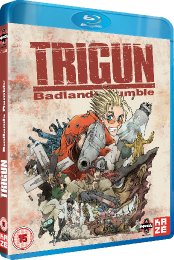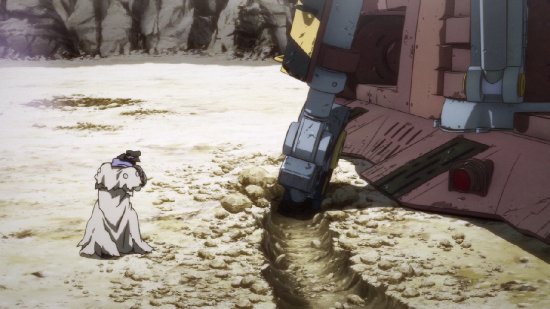Review for Trigun Movie: Badlands Rumble
Introduction
As usual when a new batch of check discs arrives, I give them a quick spin just to take a look at the specs, and check that the disc actually works. I did the same when Trigun Badlands Rumble dropped through my letterbox, and immediately a small part of me began hoping that I would hate this movie.
You wouldn’t expect that from someone for whom the Trigun series was a gateway drug into anime. My first anime on DVD were shows like Love Hina, Fruits Basket, and Kiddy Grade. Trigun came out not too long after these shows, and offered my first glimpse of a crossover anime, a show that built on the great skills and talent of Japanese animators and story creators, but was designed directly for a foreign market. Indeed, the Trigun series was more of a success in the West, than in its native Japan, playing to an audience steeped in Western lore, of tales of gunfights and showdowns, rather than samurai and ninja. I greedily absorbed every DVD that was released, back in the days when a 26 episode series was given an eight volume release schedule, loving its comic action tale of a sharpshooting pacifist in a futuristic distant world
Vash the Stampede is the Humanoid Typhoon, the ultimate outlaw with a $$60 billion reward on his head. Trouble precedes him, and he leaves devastation in his wake... through no fault of his own however, as he’s a pacifist who’s into Love and Peace. It’s just that trouble seems attracted to him, so much so that he has a couple of insurance claims adjusters, ‘Derringer’ Meryl Stryfe, and ‘Stun Gun’ Milly Thompson trailing him, trying to keep his tendency to cause destruction in check. He also attracts the attention of a gun-toting preacher named Nicholas D. Wolfwood who’s trying to comprehend Vash’s take on life, so at odds with the harsh world they all live in. They were the main characters in a sci-fi, action, comedy drama that I still watch on a regular basis today.
It’s been fifteen years since it was made though, just prior to the digital revolution that altered the anime business forever. In some ways it’s a very old fashioned, cel animated show, very much of its time. It’s also a complete story, which begs the question of why make a movie, and why do so some 12 years after the series aired? For 2010 saw the release of Trigun Badlands Rumble, the spin-off feature film. The creators have taken a leaf out of Cowboy Bebop, and set the film during the series run. They’ve also set it early enough into the show that the main story has no relevance here. It’s during that part of the show that was most episodic, most adventurous, and most steeped with comedy.
20 years previously, Vash wandered his way into a double-cross in progress, when a bank robbery went sour. He chose to stop a leader and his gang killing each other over their loot, he rolled the dice and hoped for the best, but the leader warned him that not all choices are the right ones. That gang leader was Gasback, and 20 years on, he’s the most feared robber there is. In fact, the bounty on his head has just risen to $$300 million. The rumour is that he’ll hit Macca Town, and its leader Kepler has hired every low-life bounty hunter around to defend it, or rather the giant bronze statue that he has had erected in his own honour. That statue has been insured for $$5 billion, a ridiculous figure that has Milly and Meryl in town trying to find some way to get the Bernadelli Insurance Company off the hook. Gasback is indeed targeting Macca Town, but his aim isn’t the statue, he’s after something far more ominous... revenge. Only he’s picked up an unlikely bodyguard, Nicholas D. Wolfwood. And like a fly drawn to honey, Vash the Stampede is on a sand steamer headed straight for trouble, only he’s following his lust. One particular bounty hunter named Amelia in fact, tough, high kicking, and gorgeous to boot, only she’s got a very personal reason why she’s after Gasback. All hell is about to break loose!
Picture
Trigun Badlands Rumble gets a 1.78:1 widescreen transfer at 1080p resolution on this Blu-ray disc. Studio Madhouse have gone to town on this film, maintaining the feel of the original cel-animated television series, while updating it with modern digital animation techniques, expanding it to the wider scope, and making full use of CGI to realise the grander set pieces and future retro technology. It may look a little dated to people more used to current anime, as the character designs match those of the television series. But the animation is far more fluid and detailed, there’s a whole lot more going on in each frame, and the action is astounding. The look of the television series, the arid alien world that the story occurs on, the glaring sunslight, the over exposed feel is all recreated with loving accuracy, and a distinct layer of film grain has been applied to the digital animation to match the look of the television show.
The transfer does justice to the animation, bringing out the best of the detail, recreating the film’s colour palette and showing off the updated Trigun world to excellent effect. The only quibble might be a little digital banding in darker scenes, and in areas of large gradated colour. Also, Funimation are in the habit of re-versioning their properties, and they usually replace the original credit scrolls with English language credits. The Kazé disc retains the original Japanese credits, and these aren’t subtitled.
The images used in this review are sourced from the PR and aren’t necessarily representative of the final retail release.
Sound
You get the option of DTS-HD HI RES 5.1 audio in Japanese, English, and German on this Blu-ray, as well as Dolby Digital 2.0 Stereo in the same languages. Now if you are going to have lossy audio on a Blu-ray, HI RES is probably the format to go for, as it is at least a high definition format, maintaining a constant bitrate of 3Mb per second throughout the film. But it is still a lossy format, which limits the fidelity of the audio when it’s needed the most. The irony of it is that the US release from Funimation with its lossless audio in Dolby TrueHD, is actually more efficient than this. Someone did the analysis and worked out that the average bitrate for both English and Japanese on that disc was less than 3Mb. Its dynamic audio means that the bitrate can drop down when the sound quietens in the film, and peak just as high as needed for the more raucous bits.
This being a Kazé disc, subtitles and audio are locked for the duration, you can’t change them via the remote, only via the main and pop-up menus. One of my criticisms of Kazé’s authoring has finally been addressed with this release, that of accessibility for English HOH users. You can finally turn on the subtitles with the English audio, although it’s a little counterintuitive in the menu. You can’t turn off the subtitle stream while watching the Japanese audio though. The subtitles are accurately timed and free of error, although the small white font for the English subtitles isn’t the most legible.
Having said all that about the audio, I must admit that my home set-up isn’t the optimal for judging the differences in quality of high end audio, but genuine audiophiles may quibble. I did notice in the Japanese version that I watched that the action and music was favoured a little more than the dialogue, which was a little low in the mix. The Japanese version is definitely the way to go, as the original cast all return to reprise their roles, and I always was a fan of Masaya Onosaka as Vash. The dialogue is clear throughout, and the action really punches with impact through the surround setup. I sampled the English audio, and with the exception of Jonny Yong Bosch, the roles were all recast, and it didn’t really have the feel of the television series, instead just sounding like a generic Funimation dub. Tsuneo Imahori returns to score the film’s music, and while the sound was definitely Trigun in feel, I felt that there weren’t enough call backs to the original TV series, and reusing a few more of those classic cues would have been the icing on the cake. The biggest downer is that when the show’s theme song finally does reappear, it’s buried beneath the cacophony of the climactic action sequence, and it barely registers.
Extras
It’s a Kazé release, which explains the title being upside down on the spine of the Blu-ray case. It’s also apparent that no-one in France has heard of PJ and Duncan, as someone would have advised them that using the phrase “Let’s Get Ready To Rumble” as the tagline on the back won’t be possible again for another... millennium.
Inside you’ll find two discs, one on each inner face of the case. You’ll also find a fold-out mini-poster with the US artwork, as well as an eight-page booklet with an introduction from the producer, some character bios, and some production notes.
In the US, Funimation’s release was a BD50 with everything on one disc. The Kazé release splits it in two, with the film on a BD25, and the extras on a DVD.
Put the Blu-ray into the player and you’re presented with the choice between English and German animated menus. The only difference between the two is in the trailers that you get to watch. The German menu offers 720p trailers for Code Geass, Summer Wars, and The Girl Who Leapt Through Time, as well as a 1080i trailer for Redline. The English menu offers trailers that are in 1080p for Black Lagoon, the forthcoming Journey To Agartha (Children Who Chase Lost Voices From Deep Below), and Planzet and Princess Jellyfish. The latter two just rub salt in the wound as this disc is the only UK disc that offers HD footage for those titles. We only get them on DVD here.
The DVD houses the extra features, and it too is presented with English and German menus, and locked subtitles.
Staff and Cast Interviews lasts 74 minutes, and gathers all the individual interviews from the US Blu-ray and presents them as one long featurette. Masaya Onosaka (Vash), Show Hayami (Wolfwood), Hiromi Tsuru (Meryl), and Satsuki Yukino (Milly) all talk about returning to the Trigun universe after twelve years, while Maaya Sakamoto (Amelia) and Tsutomu Isobe (Gasback) talk about their first experience with Trigun. It’s also pretty rare to even see the traditionally reclusive mangaka, the odd time they do pop up in a featurette, their off-screen or mosaicked, so it’s a treat to see and hear the creator of Trigun, Yasuhiro Nightow talk about the film. There are also contributions from director Satoshi Nishimura and character designer Takahiro Yoshimatsu.
The Making Of lasts 4 minutes, and is a chance to see the Japanese voice actors laying down the dub for the film.
Finally in Premieres, which lasts 47 minutes, we get footage from the Screening at Kawasaki Cinecitta, and the Cinema Sunshine Ikebukuro Movie Premiere Digest, both of which offer stage greetings and interviews with the cast and crew in front of an appreciative movie-going audience.
As mentioned, the US release from Funimation has everything on one BD50, and it has even more in the way of extra features, although they are mostly promotional material in the way of trailers and commercials. There are also apparently some intriguing extras regarding the Black Cat. If you’ve seen the TV series, you’ll know that the black cat is as much an integral character in Trigun as Vash himself, and it’s a shame that the Kazé release omits these. I just want to know what they are.
Conclusion
I put aside a night to watch the film. The next day, before starting the review, I went and ordered the Funimation Blu-ray release of Trigun: Badlands Rumble.
I love this film! These days it seems that every anime to make even the slightest splash is getting a spin-off feature, as if the anime business has determined that in these days of falling revenues from television, the real money is getting bums on seats inside cinemas. Nowadays a show doesn’t even need to end its run before getting a movie, and most of those are just polished recaps of the series. Only Madoka Magica’s third film will have original material, and one can’t imagine what the Strike Witches feature will have to add to its dubious charms. Admittedly I’m intrigued at what the Stein’s;Gate feature will do, but is the Tiger and Bunny movie really necessary? But then there’s Trigun, which took a lengthy twelve years between the end of the television series and the premiere of its spin-off movie. That is enough time, indeed more than enough time to gauge its strengths and its weaknesses, determine what fans want, and whether there is a real demand for such a film. It’s also enough time to come up with an original story.
The thing is that Trigun was more of a success outside Japan than within, and it is positive feedback from US and European fans that keeps Trigun alive to this day. It was actually this feedback, and feedback from the then distributor of Trigun in the US that planted the seeds of the spin-off movie, and as opposed to the usual navel-gazing nature of Japanese anime that we in the West just take advantage of, this is one instance where the existence of the movie is more down to us. That explains why the extra features are so lavish on these releases, as opposed to the usual vanilla nature of anime, which has to be supplemented by Funimation commentary tracks and the like.
The good news is that Trigun: Badlands Rumble is a feature that works fine as a stand-alone story, although naturally fans of the existing series will get more out of it. There are complete character and story arcs through the film, and at no point do you feel as if you’re missing something. It’s set during the series run, around episodes 9 and 10 if you’re counting. At this point in the series, it was just a set of episodic comedy adventures, rather than the darker serial drama that would come later on. Meryl and Milly have at this point accepted that the goofball in the red coat really is the Humanoid Typhoon, and Wolfwood is on the scene, fascinated by the pacifist gunslinger, but there aren’t any hints as yet to Vash’s real nature, and neither has the main storyline swung into effect. At this point in the series, it was a case of Vash winding up in a new town, discovering a local bit of drama, and somehow helping solve the problem through sheer good natured idiocy, with Meryl and Milly trying desperately to limit the chaos that he causes in the process.
The movie plays just like a feature length version of one of these episodes, and that was exactly the right tack to take with the film. It’s pure fun from beginning to end, with larger than life characters, great action sequences, and no little comedy. Where the film is an absolute joy is that you get the classic Trigun series with a feature film budget, and a modern 21st Century makeover that applies the current state of the art animation techniques to a series with great nostalgic appeal. The great success is in maintaining the look of the classic Trigun series, the grainy film, the overexposed brightness of the alien world under two suns, and the unmistakeable look of the characters, but then enhancing all this with flawlessly blended CGI and giving the world life in a way that the series could never afford. This is now a world populated with hundreds of background characters, every scene has something going on in the background and nothing is static. And seeing the future world tech given CGI life, the giant feel of the Sand Steamer, the massive heft of the Plant, gives the film scope in a way that the TV series could only hint at.
The story is strong, but simple, with the bad ass bank robber Gasback looking for revenge, and targeting Macca Town. The head honcho in that town hires every mean looking Bounty Hunter around to guard his wealth. One of those bounty hunters, Amelia has a very personal reason beyond just a simple reward to hunt Gasback, and into this incipient powder keg wanders Vash the Stampede. Through his good-natured meddling, he tries to shift events to a less lethal outcome, although this time it’s made more difficult as it seems that he’s on opposing sides to his occasional ally Nicholas D. Wolfwood. It’s an entertaining and fast-paced story, replete with action and excitement, but also with Trigun’s trademark comedy. But there’s no little heart as well, while there’s a fundamental question at the heart of the movie, asking if Vash’s mantra of Love and Peace can even be appropriate if neither side of a conflict want either.
Newcomers to the Trigun universe will quickly get into the swing of things, picking up on the regular characters’ idiosyncrasies while engaging with the story. For long term fans of Trigun, there are more than enough nods and winks at the camera for you to feel right at home with the film. And yes, the Black Cat makes an appearance or two. Best of all, this film has a barroom brawl to end all barroom brawls, one that must have been a nightmare to animate. If this is the quality that an extended break between TV series and movie can ensure, then I’d very much like to see another Trigun feature film, although maybe not after another twelve years. Six years would be fine...
So here’s the thing. Funimation’s BD release of Trigun: Badlands Rumble... It doesn’t have the title upside down on the spine, and it doesn’t have “Let’s Get Ready To Rhumble” on the back. It’s on a BD 50, with everything conveniently on one disc, not split across a BD 25 and a DVD. It has more extra features than the UK disc. It has lossless Dolby TrueHD audio, not lossy DTS-HD HI RES. It takes more room on the Funimation disc (implying less compression, and I’m hoping that it’s absent that colour banding). The Funimation disc also apparently doesn’t lock its audio and subtitle streams. And finally it’s coded for Regions A and B. Any one of these complaints alone would be petty, taken altogether they become difficult to ignore.
As long as Kazé fail to offer UK viewers what Funimation offer the US fans (or for that matter what Madman offer Australian fans), then I just can’t recommend this disc. The most I can say is that you should give this disc a rent, and if you like the film, you know what to do.











































Your Opinions and Comments
Be the first to post a comment!